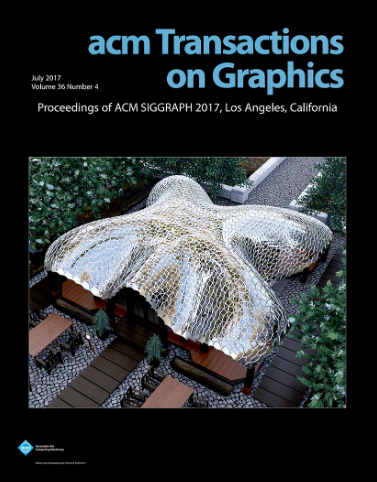神经交叉:一种计算交叉场的神经方法,用于四网格生成
IF 9.5
1区 计算机科学
Q1 COMPUTER SCIENCE, SOFTWARE ENGINEERING
引用次数: 0
摘要
四边形网格生成在计算机辅助设计与工程(CAD/E)数值模拟中起着至关重要的作用。制作高质量的四边形通常需要满足四个关键标准。首先,四边形网格应与主曲率方向紧密对齐。其次,奇点应该有策略地放置并有效地最小化。第三,网格要准确符合尖锐的特征边缘。最后,四方阵结果应表现出对噪声和微小几何变化的鲁棒性。现有的方法通常是先计算一个规则的交叉场来表示表面上的四边形元素方向,然后提取一个与该交叉场紧密对齐的四边形网格。这种方法的主要挑战是平衡交叉场的平滑性及其与预先计算的主曲率方向的对齐,这些方向对小的表面扰动很敏感,并且通常在球形或平面区域中定义不清。为了应对这一挑战,我们提出了NeurCross,这是一个同时优化交叉场和神经符号距离函数(SDF)的新框架,其零水平集充当输入形状的代理。我们的联合优化以三个因素为指导:优化后的SDF曲面与输入曲面的忠实逼近、交叉场与SDF曲面导出的主曲率场的对齐以及交叉场的平滑性。作为中介,神经SDF在两个重要方面起作用。首先,它提供了一个可选择的、可优化的基面,显示出更规则的主曲率方向,用于引导交叉场。其次,我们利用神经SDF的Hessian矩阵隐式地执行与主曲率方向的交叉场对齐,从而消除了显式曲率提取的需要。大量的实验表明,NeurCross在奇点放置、对表面噪声和表面波动的鲁棒性以及与主曲率方向和尖锐特征曲线的对齐方面优于最先进的方法。本文章由计算机程序翻译,如有差异,请以英文原文为准。
NeurCross: A Neural Approach to Computing Cross Fields for Quad Mesh Generation
Quadrilateral mesh generation plays a crucial role in numerical simulations within Computer-Aided Design and Engineering (CAD/E). Producing high-quality quadrangulation typically requires satisfying four key criteria. First, the quadrilateral mesh should closely align with principal curvature directions. Second, singular points should be strategically placed and effectively minimized. Third, the mesh should accurately conform to sharp feature edges. Lastly, quadrangulation results should exhibit robustness against noise and minor geometric variations. Existing methods generally involve first computing a regular cross field to represent quad element orientations across the surface, followed by extracting a quadrilateral mesh aligned closely with this cross field. A primary challenge with this approach is balancing the smoothness of the cross field with its alignment to pre-computed principal curvature directions, which are sensitive to small surface perturbations and often ill-defined in spherical or planar regions. To tackle this challenge, we propose NeurCross , a novel framework that simultaneously optimizes a cross field and a neural signed distance function (SDF), whose zero-level set serves as a proxy of the input shape. Our joint optimization is guided by three factors: faithful approximation of the optimized SDF surface to the input surface, alignment between the cross field and the principal curvature field derived from the SDF surface, and smoothness of the cross field. Acting as an intermediary, the neural SDF contributes in two essential ways. First, it provides an alternative, optimizable base surface exhibiting more regular principal curvature directions for guiding the cross field. Second, we leverage the Hessian matrix of the neural SDF to implicitly enforce cross field alignment with principal curvature directions, thus eliminating the need for explicit curvature extraction. Extensive experiments demonstrate that NeurCross outperforms the state-of-the-art methods in terms of singular point placement, robustness against surface noise and surface undulations, and alignment with principal curvature directions and sharp feature curves.
求助全文
通过发布文献求助,成功后即可免费获取论文全文。
去求助
来源期刊

ACM Transactions on Graphics
工程技术-计算机:软件工程
CiteScore
14.30
自引率
25.80%
发文量
193
审稿时长
12 months
期刊介绍:
ACM Transactions on Graphics (TOG) is a peer-reviewed scientific journal that aims to disseminate the latest findings of note in the field of computer graphics. It has been published since 1982 by the Association for Computing Machinery. Starting in 2003, all papers accepted for presentation at the annual SIGGRAPH conference are printed in a special summer issue of the journal.
 求助内容:
求助内容: 应助结果提醒方式:
应助结果提醒方式:


